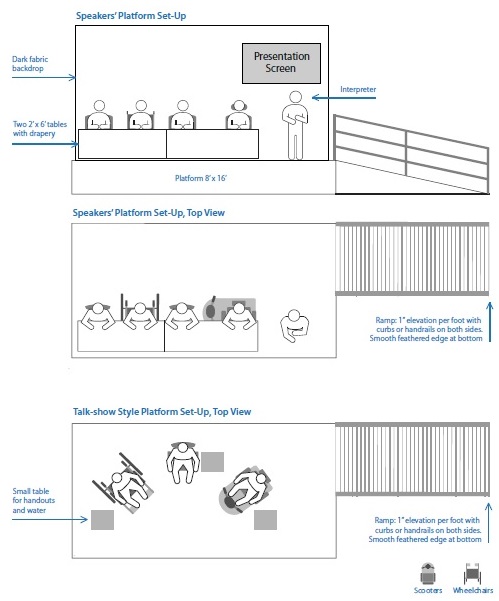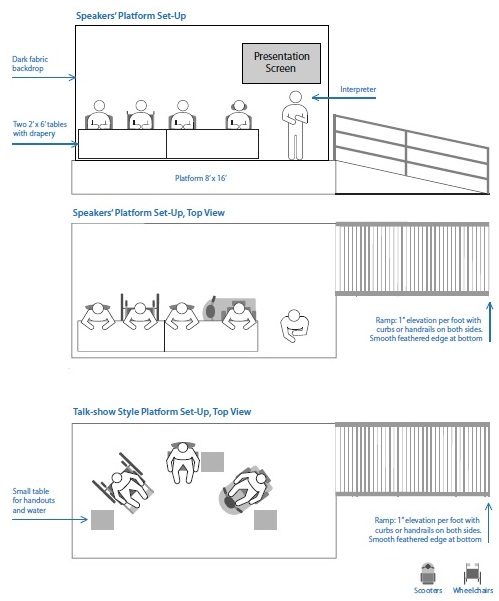The Presentation Area / Speaker’s Platform Design and Considerations
Two layouts are provided here, and either could be adapted for additional presentation elements.
Both layouts incorporate presentation screens that are easily viewed from all areas of the room. Captioning should run on at least one if not all screens showing slides, videos, or live feed of the presenters. Space for a qualified interpreter for people who are Deaf or hard of hearing should be included in all plans, and seating nearest interpreters should be reserved for individuals using those services.
Find out what accommodations your presenters will need for their presentations. Presenters with disabilities may have very specific preferences for microphone type, podium or lectern use, and panel table set-up. The objective is to provide all of your presenters with environments and tools that are comfortable for them.
When possible, offer presenters a choice of microphone type (headset, lavaliere/lapel, table-set, or hand-held) so that presenters can use the type that best meets their needs and preferences.
When working with multiple presenters, take steps to ensure each presenter receives equal status in the presentation environment. For example, if a panel includes four presenters, one of whom uses a wheelchair, be sure to set a space equivalent to two chairs at the panel table for the wheelchair user. If some of the presenters will be using a standing podium, offer a similar option, such as a microphone on a boom stand or a lowered podium, for the presenter who uses a wheelchair.
In no case should a presenter who uses a wheelchair or scooter be asked to present from the floor while others present from a stage. Neither should a presenter using a mobility device be seated at the end of a skirted table instead of with the other presenters. Rather, create an environment where each panelist or presenter is viewed on equal ground with the others. Podiums should be avoided, unless a presenter requests one specifically to accommodate his or her needs.
If slide shows will be used, plan in advance for how they will be managed. You may need to have facilitators who advance slides instead of speakers, or have speakers use remote controls so that they can advance slides from anywhere in the room. This technology is more and more commonly available, though the remote controls vary from vendor to vendor, and some are easier to operate than others. A practice session for each presenter in advance is ideal.
Accessible Presentation / Speaker’s Platform - Traditional
This design shows a stage area with multiple panelists / presenters. Click [here] ... for a full-page, printable handout.

Accessible Presentation Area Set-Up
All presentation platforms must be accessible by ADA-compliant ramps (minimum 1” rise per 12” slope, with curbs or handrails on both sides of the ramp). The back edge of the platform should be placed against a wall to eliminate one edge where speakers could possibly fall off . Provide for a 5’ turning radius when presenters will be mobility device users to ensure adequate maneuvering space. Allow additional space for the interpreter for the Deaf and hard of hearing.
Accessible Presentation / Speaker’s Platform - Talk Show Style
This style is often used for a more conversational presentation, typically with a moderator and one or more guests. Side tables should be provided (for water, notes, or other materials) for each guest. Individuals who use wheelchairs or scooters may need a higher side table than other guests. Click [here] ... for a full-page, printable handout.

Accessible Presentation Area Set-Up
All presentation platforms must be accessible by ADA-compliant ramps (minimum 1” rise per 12” slope, with curbs or handrails on both sides of the ramp). The back edge of the platform should be placed against a wall to eliminate one edge where speakers could possibly fall off . Provide for a 5’ turning radius when presenters will be mobility device users to ensure adequate maneuvering space. Allow additional space for the interpreter for the Deaf and hard of hearing.

User Comments/Questions
Add Comment/Question